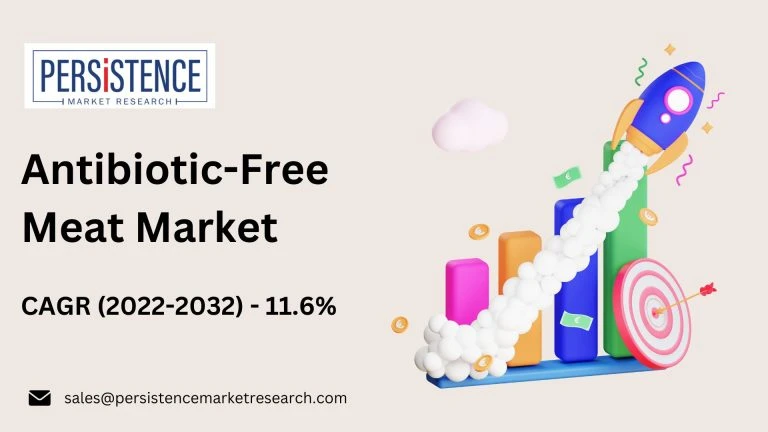
The global antibiotic-free meat market, valued at approximately USD 148.67 billion, is poised for significant growth, with projections indicating it will reach USD 445 billion by 2032. This expansion reflects a compound annual growth rate (CAGR) of 11.6% from 2022 to 2032. Antibiotic-free meat currently makes up 25% to 30% of the global meat products market. From 2017 to 2021, the market experienced a CAGR of 8.1%, driven by a growing consumer preference for healthier, chemical-free meat. This trend is fueled by increasing awareness of the risks associated with antibiotic use in livestock and its potential effects on human health. As consumers demand antibiotic-free products and are willing to pay a premium for them, major players in the market are implementing strategies to minimize antibiotic use in meat production. This shift is expected to support continued robust growth in the antibiotic-free meat sector.
The global food industry is experiencing a major shift as consumers increasingly seek healthier and more sustainable food options. A prominent trend in this transformation is the rising demand for antibiotic-free meat, with chicken becoming a major focus in this sector. This article delves into the antibiotic-free meat market, highlighting the growth dynamics, market drivers, challenges, and future outlook, with a special emphasis on chicken.
Key Findings of the Report
1. Market Chain Analysis
The report assessed antibiotic-free meat availability across four major U.S. market chains: Walmart, Kroger, Costco, and Safeway. The analysis revealed a notable lack of antibiotic-free options in these stores, with limited product ranges and inconsistent availability.
Walmart: Despite its extensive meat department, Walmart\'s selection of antibiotic-free meat is sparse. The report indicates that antibiotic-free options are often limited to specific cuts or brands and may not be consistently stocked.
Kroger: Kroger offers some antibiotic-free meat products, but the selection is not extensive. The report notes that while antibiotic-free options are available in certain stores, they are not uniformly present across all locations.
Costco: Costco, known for its bulk offerings, has a limited range of antibiotic-free meat products. The report highlights that while Costco does carry some antibiotic-free options, the selection is narrow and may not meet the demand of health-conscious consumers.
Safeway: Safeway\'s availability of antibiotic-free meat is also inconsistent. The report finds that while some stores offer antibiotic-free options, the selection varies, and availability may be sporadic.
2. Consumer Demand and Expectations
Consumer demand for antibiotic-free meat is growing rapidly, driven by concerns over health risks, antibiotic resistance, and a preference for cleaner, more transparent food options. The report underscores that consumers are increasingly seeking out antibiotic-free products and are willing to pay a premium for meat that aligns with their values.
The lack of sufficient antibiotic-free meat options in these major market chains indicates a disconnect between consumer expectations and the availability of these products. This gap highlights a need for market chains to better align their offerings with consumer demand.
Implications for Consumers
Health Concerns
The absence of antibiotic-free meat options in major market chains is a significant concern for health-conscious consumers. Antibiotic use in livestock is associated with potential health risks, including the development of antibiotic-resistant bacteria. For consumers who prioritize health and safety, the limited availability of antibiotic-free meat can be frustrating and may lead them to seek alternatives elsewhere.
Access and Affordability
The lack of antibiotic-free meat in prominent chains also raises issues of access and affordability. Consumers who prefer antibiotic-free meat may find it challenging to locate these products, particularly in areas where such options are scarce. This situation can disproportionately impact lower-income consumers who may have fewer choices and higher prices for antibiotic-free meat.
Industry Implications
Competitive Advantage
For market chains, offering a diverse range of antibiotic-free meat products can serve as a competitive advantage. As consumer preferences shift towards cleaner and more sustainable food options, market chains that fail to meet this demand may lose market share to competitors who prioritize antibiotic-free offerings.
Supplier Relationships
The report suggests that the limited availability of antibiotic-free meat may be linked to supply chain and supplier challenges. Market chains may need to strengthen relationships with suppliers of antibiotic-free meat and invest in sourcing strategies to ensure consistent availability of these products.
Regulatory Compliance
With increasing regulatory pressure on antibiotic use in livestock, market chains must also consider compliance with evolving regulations. Proactively offering antibiotic-free meat products can help market chains stay ahead of regulatory changes and demonstrate a commitment to responsible and ethical practices.
Steps to Address the Issue
1. Expanding Product Range
Market chains should consider expanding their range of antibiotic-free meat products to meet growing consumer demand. This includes increasing the variety of cuts, brands, and types of meat available in stores.
2. Improving Supply Chain Management
Enhancing supply chain management can help ensure consistent availability of antibiotic-free meat. Market chains should work closely with suppliers to address any challenges related to sourcing and distribution.
3. Increasing Consumer Education
Educating consumers about the benefits of antibiotic-free meat and the availability of these products can help drive demand. Market chains can invest in marketing and promotional efforts to raise awareness and inform consumers about their antibiotic-free offerings.
4. Monitoring and Reporting
Market chains should regularly monitor the availability of antibiotic-free meat and address any gaps or inconsistencies. Transparent reporting on product availability and sourcing practices can help build consumer trust and align with expectations.
Conclusion
The report highlighting the lack of antibiotic-free meat in four major U.S. market chains underscores a significant gap between consumer demand and product availability. As consumers increasingly seek out cleaner, healthier food options, market chains must respond by expanding their range of antibiotic-free meat products and addressing supply chain challenges.
By aligning their offerings with consumer preferences and regulatory requirements, market chains can not only meet demand but also gain a competitive advantage in a rapidly evolving food landscape. Addressing these issues effectively will require a collaborative effort between market chains, suppliers, and consumers to ensure that antibiotic-free meat becomes a more accessible and integral part of the food supply.


